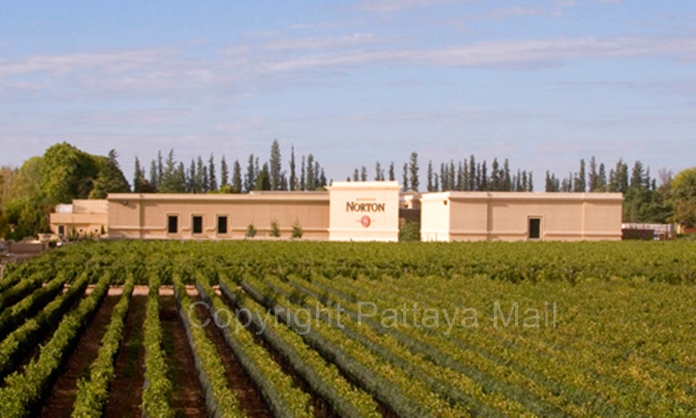
After dinner the other night, I was having a chat with the dogs about our favourite wine grapes, and one of them mentioned Malbec. I can’t remember who brought up the subject; it could have been Black, who is extremely interested in grapes. On the other hand, it might even have been me. But honestly, we have such hilarious animated conversations that I nearly always forget who said what.
You probably know that Malbec grapes are associated with Argentina. This wasn’t always the case, because Malbec (MAHL-bek) was originally grown in France. But it fell out of popularity and over the years the acreage dwindled away, although the grape still thrives in the Cahors region of South-West France.
The Malbec grape didn’t appear in Argentina until the middle of the nineteenth century, when a provincial governor requested that French Malbec vine cuttings be brought to the country. For a long time, Argentinean wines had little impact on the rest of the world, because in order to meet local demand, most producers were interested in quantity rather than quality.

Over the years, the industry had its ups and downs but by the 1990s the wines started to improve significantly as winemakers began to realise the potential for international sales. Finally, things started to change for the better. At around the same time, Malbec was rediscovered by the Argentine wine industry and today it’s the most widely planted red grape variety in the country.
Both the wines this week come from the famous Bodega Norton in Mendoza, though this is not obvious until you scan the minuscule print on the back label. They are entry-level wines intended for export and are exceptionally good value.
Bodegas Norton has been making wine since the end of the nineteenth century, when the splendidly-named engineer, Sir Edmund James Palmer Norton first set eyes on the Mendoza countryside.
Impressed by the potential of the land, he founded a new winery which he modestly named after himself. In 1875, he planted his first vines in Mendoza’s Lujan de Cuyo district, high in the Andean foothills. Today, Bodega Norton has become an international name, exporting its wines to more than sixty countries.
It has nearly three thousand acres of vineyards with over a hundred and fifty families of vineyard workers living and working there.
Vistaflor Sauvignon Blanc – Chenin Blanc (white)
My Spanish is not so hot these days, but I presume that Vistaflor means “A view of the flowers” or something along those lines. The wine is a lovely rich yellow-gold with hints of green.
There’s a clean, intense and refreshing aroma of citrus, honey and dusty pomelo, if you can imagine such a thing. The taste is predictably bright and sharp and seems to take quite a lot of its character from the Sauvignon Blanc (SOH-vihn-yohn BLAHN) in the blend. It’s softened by the Chenin Blanc (SHEN-ihn BLAHN) a grape which hails from the Loire Valley of France but now found throughout Mexico and South America.
They’ve used a 50-50 percentage of each grape variety in the blend and to preserve the freshness and vitality, the wine was fermented in stainless steel tanks. The wine has a pleasant mouth-feel with plenty of lively acidity. You’ll notice that it has quite a bit of spiky assertiveness but there’s generous fruit on the taste to balance it out.
This light-bodied wine has an attractive long dry finish too, so if you like fruity dry whites with a bit of zing you’ll probably enjoy this one.
It’s just under 13% ABV and it would probably be at its best with food. The wine would make a good partner for medium-flavoured fish dishes.
It worked extremely well with a grilled chicken fillet, but I’d perked it up with several cloves of garlic and chili pepper. The chicken I mean, not the wine.
Vistaflor Malbec – Sangiovese (red)
You can predict a lot about the taste of this wine from the two grape varieties used in the blend. The Sangiovese (san-joh-VAY-zeh) grape hails from Italy and if you’ve ever drunk a glass of Chianti, you’ve tasted Sangiovese. The grape usually produces dark, inky wines with intense fruity flavours, soft tannins and velvety textures.
The wine is a brilliant, dark ruby-red, with a gorgeous aroma of red fruit, black cherries and some spiciness in the background. The aroma wafts out of the bottle the moment you open it. Thanks to the Malbec in the blend, the taste is much softer, rounder and more approachable than you might expect because Argentinean Malbecs tend to be less tannic than their French cousins.
In contrast, the Sangiovese gives the wine a touch of assertiveness. It’s as dry as they come, softened by loads of cherry flavours from the Sangiovese and blackberries from the Malbec. The tannins are extremely soft – barely noticeable in fact – but they add firmness to the body.
This is a rather lovely wine, but the high alcohol content it’s pretty well near the top of the destruction scale.
It would work well with assertive dishes, red meats in sauce, game or spicy food. Oh yes, I’ve just been told that Malbec goes very well with Pedigree Chum beef chunks in gravy.
The wines described in this column are generally available in Thailand, either from local outlets or from online wine suppliers.
 |
 |
 |




